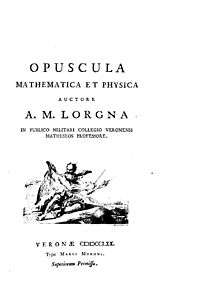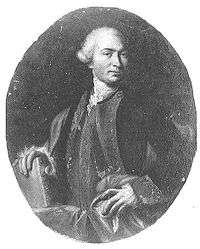Antonio Maria Lorgna
| Antonio Maria Lorgna | |
|---|---|
|
Painting by Pietro Rotari (1707-1762) | |
| Born |
18 October 1735 Cerea, Venetian Republic, now Italy |
| Died |
28 June 1796 (aged 60) Verona, Venetian Republic, now Italy |
| Fields |
Mathematics Enginering |
| Alma mater | University of Padua |
| Known for | Founder of the Accademia nazionale delle scienze |
Antonio Maria Lorgna (1735-1796) or Antonio Mario Lorgna (as he signed his works) was a mathematician from Italy in the 18th century, founder of the Accademia nazionale delle scienze.
Life and work

Practically nothing is known about the first twenty years of Lorgna. He was the son of a cavalry officer of the Venetian army and in 1757 he was in Dalmatia probably following his father in his military duties (Dalmatia was at this time under Venetian rulers). The general governor of Dalmatia, Alvise Contarini, knowing his abilities and versatility, appointed him as his secretary and interpreter.
Returned to Venice in 1759, he begun studies in the university of Padua; he didn't achieve the graduation but he learned physics, astronomy and mathematics under professors Giovanni Poleni and Giovanni Alberto Colombo.[1]
In 1762 he was enrolled in the Venetian army and went to Croatia for few time, because he was appointed professor of mathematics in the military academy for engineers in Castelvecchio in Verona.[2] Lorgna worked at the Military College of Castelvecchio in Verona for the rest of his career teaching courses on trigonometry, mechanics, statics for construction, ballistics and hydraulics. From 1784 he was also the general governor of the college, attaining the military rank of Brigadier.
He was never married. He died when the French army was occupying Verona.[3]
Lorgna is basically known because he was the founder in 1782 of the Societá Italiana delle Scienze detta dei XL, actually the Accademia nazionale delle scienze, a leading research Italian institution.[4]
Between his eighty works, can be stated the following as the most important:[5]
- Della graduazione de'termometri a mercurio e della rettificazione de'barometri semplici (1765)
- De quibusdam maximis, & minimis: dissertatio statico-geometrica (1766)
- Dissertazione sopra il quesito: essendo le pressioni dell'acqua stagnante in ragione delle altezze... (1769)
- Opuscula mathematica et physica (1770)
- Dissertazione sopra il questio rinvenire il fondamento... (1771)
- Specimen de seriebus convergentibus (1775)
- De casu irreductibili tertii gradus et seriebus infinitis (1776)
- Saggi di statica e meccanica applicate alle arti (1782)
- Principi di geografia astronomico-geometrica (1789)
References
Bibliography
- Cerruti, L. (1994). "Dante's bones". In Kostas Gavroglu (ed.). The Sciences in the European Periphery During the Enlightenment. Dordrecht: Kluwer Academic Publishers. ISBN 0-7923-5548-2.
- Farinella, Calogero (1994). "Ricostruire la biblioteca di uno Scienziato: il caso di A. M. Lorgna". Nuncius. Vol. 9 (Num. 2): 739–758. doi:10.1163/182539184X01035. ISSN 0394-7394.
- Pepe, Luigi (2008). "Les milieux savants en Italie dans la deuxième moitié du 18e siècle". Dix-huitième siècle. Vol. 40 (Num. 1): 211–228. doi:10.3917/dhs.040.0211. ISSN 0070-6760.
External links
- O'Connor, John J.; Robertson, Edmund F., "Antonio Maria Lorgna", MacTutor History of Mathematics archive, University of St Andrews.
- Curi, Ettore. LORGNA, Antonio Maria. Dizionario Biografico degli Italiani.
- Web page of Accademia Nazionale delle Scienze detta dei XL
